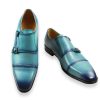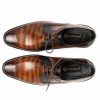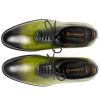Shoe linings often don’t get the spotlight, but they play a huge role in how your shoes feel, wear, and even smell (yep, we’re going there). And when it comes to lining materials, goat leather has quietly earned its crown. Lightweight yet strong, breathable yet durable—goat leather is like the unsung hero of premium footwear.
In this article, we’re diving into why goat leather is such a solid choice for shoe linings. From its natural softness to its moisture-wicking abilities, it’s got a lot going for it—especially for folks who value both comfort and longevity. We’ll break it down without getting too science-y, promise. So, if you’ve ever wondered why high-end shoes feel better on the inside, or if you’re a shoemaker looking to upgrade your materials, this is the guide you didn’t know you needed.
Key Takeaways
-
Goat leather is naturally soft, making it comfortable for all-day wear.
-
Breathability helps reduce moisture and odor inside the shoe.
-
Durability ensures long-lasting linings that resist cracking and tearing.
-
Lightweight quality keeps the shoe feeling flexible and easy on the feet.
-
Flexible grain texture allows the leather to mold naturally to the foot shape.
Properties of Goat Leather That Make It Ideal
Goat leather is a popular material in luxury footwear for good reason—it hits the sweet spot between comfort and performance. Known for its fine grain and light weight, goat leather is incredibly soft to the touch while being more durable than you’d expect. It’s especially suited for shoe linings because it molds to the shape of the foot without breaking down quickly over time.
Another key benefit is breathability. Unlike synthetic linings that trap heat and sweat, goat leather allows air to circulate inside the shoe. This helps regulate foot temperature and reduces the chances of moisture buildup, which can lead to odor or even foot fungus. No thanks, right?
Plus, goat leather’s natural lanolin content (a kind of wax) contributes to its softness and moisture resistance. It’s like the leather comes with built-in skin care—how fancy is that? In short, goat leather doesn’t just look and feel nice—it works hard behind the scenes.
Natural Softness and Flexibility
One of goat leather’s standout traits is its buttery softness, which makes slipping on a shoe lined with it feel like a treat. This is due to the unique fiber structure of goat hide. Unlike stiffer leathers, goat skin has a finer grain and higher oil content, which makes it more supple and easier to work with.
This softness isn’t just for comfort—it’s functional too. Soft linings reduce friction, helping prevent blisters and irritation during long periods of wear. That’s a big win, especially in dress shoes or boots where you might go sockless or wear them for hours on end.
Even better? Goat leather retains this softness over time. It doesn’t stiffen or crack like some cheaper lining materials. Instead, it breaks in gracefully, adapting to the contours of your foot. That flexibility adds up to better overall foot health—and fewer complaints at the end of a long day.
Moisture-Wicking and Breathability
Let’s be real—feet sweat. And when moisture gets trapped inside your shoes, things can go south quickly. Fortunately, goat leather has excellent moisture-wicking properties. Thanks to its breathable pores and natural composition, it allows sweat to evaporate rather than build up inside the shoe.
This breathability helps keep your feet cool and dry, reducing the risk of odors and skin irritation. It’s especially beneficial in hot climates or for those who wear their shoes for extended periods. No one wants to take off their shoes and clear a room—goat leather helps you avoid that embarrassment.
In fact, many shoemakers opt for goat leather precisely because it helps regulate the shoe’s internal climate. Whether you’re walking to work or standing all day, this natural airflow can make a big difference in overall comfort. It’s like having built-in air conditioning, but for your feet.
Practical Benefits in Shoe Manufacturing
For shoemakers, goat leather is more than just a comfort upgrade—it’s a practical, cost-effective solution that enhances the final product. Its pliability makes it easier to work with during the manufacturing process. Unlike tougher hides that require heavy treatment or stretching, goat leather shapes well around shoe lasts (those foot-shaped molds used during production).
Because of its fine grain and minimal blemishes, it also needs less correction or finishing. That means fewer chemical treatments, less waste, and a more natural-looking product. It’s like getting a good cut of steak—you don’t need to do much to it for it to shine.
In terms of performance, goat leather helps reduce bulk without sacrificing quality. It’s lightweight, which is a big bonus for consumers who want comfort without the clunk. And let’s not forget about its strength—this stuff holds up under pressure, whether in dress shoes or rugged work boots.
Cost-Effectiveness and Accessibility
You’d think all these benefits would make goat leather outrageously expensive—but surprisingly, it’s not. While it’s pricier than synthetic materials, it’s often more affordable than calfskin or exotic leathers. That makes it an attractive option for mid-range and luxury shoemakers looking to boost quality without inflating production costs.
Since goat leather is widely available in countries like India, Ethiopia, and Pakistan, it’s also easier to source sustainably. Tanners in these regions have honed their processes over generations, providing a consistent, high-quality product that balances performance with price.
For independent shoemakers and brands, this means you can offer premium comfort and durability without blowing your budget. That’s a win-win—better shoes for consumers, healthier margins for brands, and fewer compromises all around.
Compatibility with Other Materials
Goat leather plays well with others. Its lightweight nature makes it an excellent lining material that doesn’t fight with heavier uppers like cowhide or suede. It also bonds well with various adhesives and stitching methods, which is important when building multi-material shoes or combining traditional and modern techniques.
Its natural resilience means it holds up well next to stiffer outer layers, helping the shoe maintain shape without adding unnecessary bulk. Designers often appreciate this versatility—it opens up creative possibilities, whether you’re making sleek dress shoes or edgy high-tops.
And because it can be dyed easily and evenly, goat leather linings can also match or complement exterior colors. This makes for cleaner, more cohesive aesthetics that enhance the look and feel of the shoe overall.
Conclusion
Goat leather may not get all the attention, but it absolutely deserves a spot in the shoe industry’s hall of fame. From its luxurious softness to its natural breathability, it brings a level of comfort and durability that synthetic or lower-grade leathers just can’t match. And when it’s lining your shoes, trust us—your feet can feel the difference.
For shoemakers and buyers alike, goat leather offers a smart, sustainable choice that doesn’t skimp on quality. It’s versatile, cost-effective, and loaded with benefits that go beyond the surface. If you’ve been overlooking it till now, it might just be time to give goat leather the credit—and the shelf space—it’s earned.
FAQs
Is goat leather durable enough for everyday shoe linings?
Yes, goat leather is surprisingly durable despite its softness. It resists tearing, holds its shape, and ages well, making it ideal for daily-wear shoe linings.
How does goat leather compare to calfskin for linings?
Goat leather is softer and more breathable than calfskin, though slightly less structured. It’s often preferred for comfort, while calfskin may offer a firmer feel.
Can goat leather be used in high-end or luxury shoes?
Absolutely. Many luxury brands use goat leather linings for its comfort and breathability. It pairs well with premium uppers and adds to the shoe’s overall quality.
Does goat leather smell or hold odors?
Not if it’s tanned properly. In fact, it tends to resist odors better than synthetic materials due to its breathability and natural lanolin content.
Is goat leather eco-friendly?
It can be, especially when sourced from responsible tanneries using vegetable or semi-vegetable tanning methods. It’s also a by-product of the meat industry, reducing waste.












